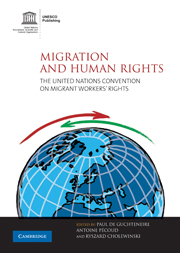Book contents
- Frontmatter
- Contents
- List of figures
- List of tables
- Notes on contributors
- Abbreviations
- 1 Introduction: The UN Convention on Migrant Workers' Rights
- PART I
- 2 Migration and human rights: the uneasy but essential relationship
- 3 Role of civil society in campaigning for and using the ICRMW
- 4 Committee on Migrant Workers and implementation of the ICRMW
- 5 Migrants' rights in UN human rights conventions
- 6 The need for a rights-based approach to migration in the age of globalization
- PART II
- Annex 1 International Convention on the Protection of the Rights of All Migrant Workers and Members of Their Families Adopted by General Assembly Resolution 45/158 of 18 December 1990
- Annex 2 Ratifications of ILO Conventions 97 and 143 and of ICRMW as at June 2009
- Index
4 - Committee on Migrant Workers and implementation of the ICRMW
Published online by Cambridge University Press: 02 December 2010
- Frontmatter
- Contents
- List of figures
- List of tables
- Notes on contributors
- Abbreviations
- 1 Introduction: The UN Convention on Migrant Workers' Rights
- PART I
- 2 Migration and human rights: the uneasy but essential relationship
- 3 Role of civil society in campaigning for and using the ICRMW
- 4 Committee on Migrant Workers and implementation of the ICRMW
- 5 Migrants' rights in UN human rights conventions
- 6 The need for a rights-based approach to migration in the age of globalization
- PART II
- Annex 1 International Convention on the Protection of the Rights of All Migrant Workers and Members of Their Families Adopted by General Assembly Resolution 45/158 of 18 December 1990
- Annex 2 Ratifications of ILO Conventions 97 and 143 and of ICRMW as at June 2009
- Index
Summary
Introduction
No country in the world today is untouched by migration. In recent years, migration has become an important topic for international conferences, such as the UN General Assembly's HLD in September 2006. Yet, as the former High Commissioner for Human Rights, Louise Arbour, has said: ‘While the debate continues to be centred either on the perceived challenges posed by migration, or on its contribution to development and poverty alleviation, the inextricable connection of migration with human rights has yet to permeate discussions and policy. The vulnerability of migrants to abuse should warrant a better understanding of their rights, as well as more – not less – protection.’
In order to address the special needs of migrants in the protection of their human rights, the General Assembly adopted the ICRMW on 18 December 1990. Almost thirteen years later, on 1 July 2003, the Convention entered into force, and on 1 January 2004, the CMW was established, thereby becoming the seventh UN human-rights treaty monitoring body.
Human-rights treaty monitoring bodies monitor the State Party's compliance with their respective treaties. They do this mainly through the consideration of States Parties' reports. Some treaty bodies also have the possibility of examining inter-state or individual communications that denounce violations by a State Party of any of the rights contained in the treaty concerned. Members of treaty bodies are independent experts, elected periodically by the meeting of States Parties to the treaty in question. Most treaty bodies meet two or three times a year.
- Type
- Chapter
- Information
- Migration and Human RightsThe United Nations Convention on Migrant Workers' Rights, pp. 100 - 121Publisher: Cambridge University PressPrint publication year: 2009
- 4
- Cited by

